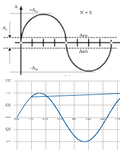sridivya pathapati
Junior Member level 2
hiii..can u tell me the sample frequency if the frequency inputs are of 1.2khz and 2.2khz?????
Follow along with the video below to see how to install our site as a web app on your home screen.
Note: This feature may not be available in some browsers.
 with significant harmonic content and the triangle waves have the same harmonics as square waves except the phase is not complementary but rather in phase, so Shannon's theorem cannot apply without some discussion as the the sampling of the harmonic content and preservation of the original signal. Your Rule of Thumb of 4x f based on 3db approximation neglects the harmonic content and Fourier transform or at least some discussion on Spectral Density of the signal. The conclusion is not valid since the assumptions are not stated correctly **end**
with significant harmonic content and the triangle waves have the same harmonics as square waves except the phase is not complementary but rather in phase, so Shannon's theorem cannot apply without some discussion as the the sampling of the harmonic content and preservation of the original signal. Your Rule of Thumb of 4x f based on 3db approximation neglects the harmonic content and Fourier transform or at least some discussion on Spectral Density of the signal. The conclusion is not valid since the assumptions are not stated correctly **end**